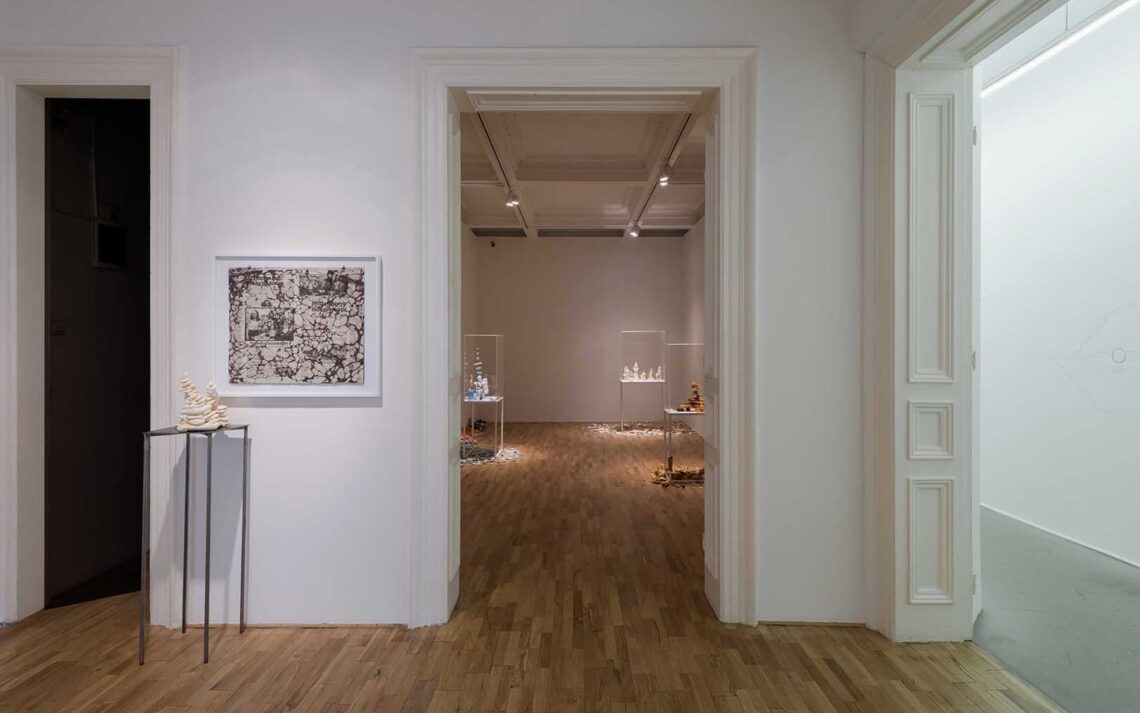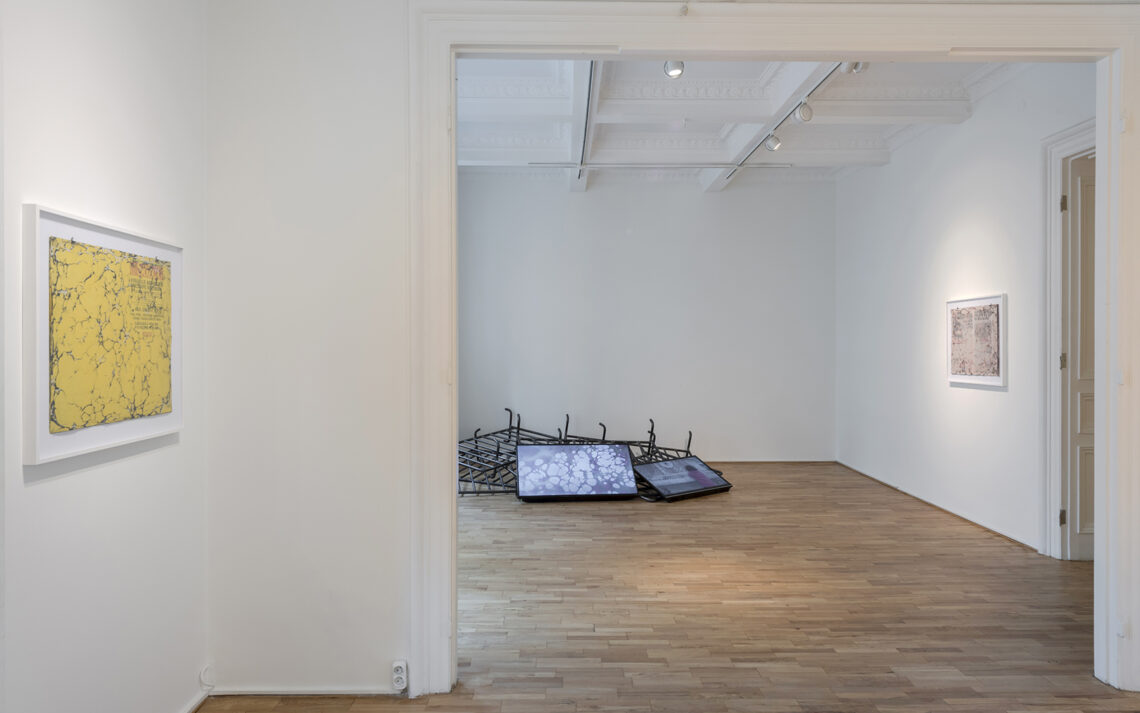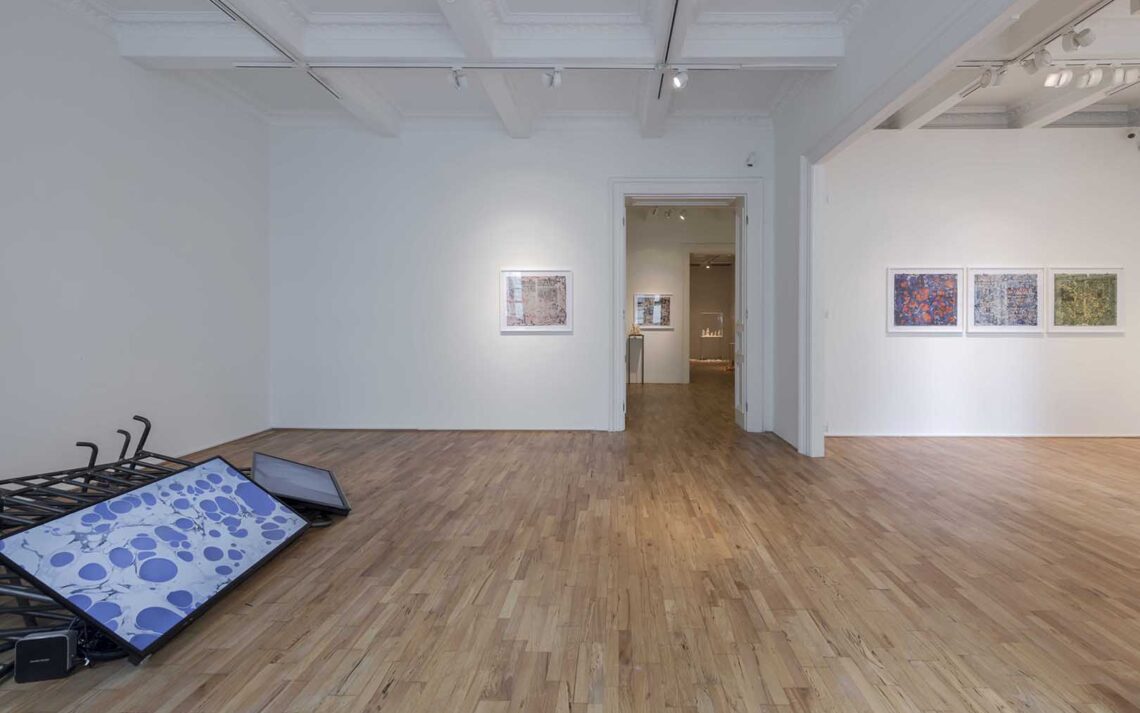
INTERRUPTION AND FLOW
Kesinti ve Akış
Solo Exhibition
2021
* Installation Photos: Kayhan Kaygusuz
Waterway: On Sibel Horada’s new works
For over ten years, Sibel Horada has been weaving new patterns in her works tracing various forms of engagement with urban, material and ecological cultures. Focusing specifically on the relationship between memory and space, she examines that which is “public’’ , “natural’’, “individual’’ and “collective’’ in instances of historical rupture, loss, destruction, dismantling and oblivion. In her practice, she articulates the production process, coincidences and materiality. Featuring video installations, sculptures and two dimensional pieces, her new exhibition “Interruption and Flow’’ emphasizes the potential of artistic production to transform our lives and perceptions in a climate of uncertainty. Touching upon multiple historical layers, Horada connects them with elegance.
The artist continues to tell the story of the untold in ‘‘Interruption and Flow’’ by going through and beyond the memory and identity construction tendencies of Historiography, without trying to teach or dictate history. The dynamic between life and soil that was at the heart of her previous solo exhibition “An Internal Garden” leaves way to the relationship between life and water in the new exhibition. Clearing Space in Still Water (2021), the main installation of ‘‘Interruption and Flow’’, takes off of her recent film The Division [Taqsim] of Water (2020), where she responds to the oppression of urban transformation and the feeling of emptiness after each destruction by imagining that water still runs through the Taksim Maqsem, and her recent video installation Flow (2019-21), which points to the endless motion in nature despite various interruptions in our lives.
During SAHA’s residency program between 2019 and 2020, Horada observed the Taksim Square, which had turned into a sea of concrete with a fate of uncertainty. She sought the possibility to once again love this space of restricted public use.
In her multi-layered short film The Division [Taqsim] of Water, produced during this program, she made an analogy between interruptions in our collective memory and the Taksim Republic Monument (1928), which was designed as a square fountain but never connected to a water source. At the same time, while seeking freshness in the still waters of the Republic Monument, whose marble basins are only filled with rainwater, she gave the monument a metaphorical life, aiming to transform the sense of personal and collective frustration regarding public space in Turkey.(1)
Horada’s sustained interest in monuments manifest in previous works like Continuous Monument (2002-…), A Fall (2013) and Liberté, Égalité, Fraternité (Hürriyet, Müsavat, Uhuvvet), (2017-21), where she creates multi-layered narratives by approaching monumentality from various perspectives continues in The Division [Taqsim] of Water. During the pandemic -where we observed the worldwide withdrawal of squares from public experience- the artist kneaded the distance between the street movements like BLM and her personal experience of ‘‘staying home’’, into the question: ‘‘will it ever be possible to be present in the public space again?’’ In 2021, we witness her attachment with Taksim Square evolve further in her installation, Clearing Space in Still Water.
As we follow the artist’s brush move like a magic wand over Taksim’s landscape, instead of her body which flew like water around the monument in The Division [Taqsim] of Water, we note once again the elements of performance and abstraction. These images on the first screen are accompanied by the process footage of the art of paper marbling, which she started applying on newspapers in 2019, on a second screen and fallen police barricades, frequently used to prevent the flow and movement of people. In the face of harsh coldness of the barricades, the poetic relationality in the videos infuses the spirit of resistance into the rest of the exhibition.
Horada’s intense, experimental relationship with paper marbling, further develops in her new works in the ‘‘Marbled Monument’’ (2019-…) series. The colors applied onto the newspapers since the municipal elections of 2019, do not hide the past news. With the power of abstraction, these works allow various associations like the visual texture of the marble of the Taksim Monument to the sea snot (mucilage), which has been on our agenda since last summer. The artist’s desire to seek freshness and beauty in still water somehow continues. While Horada presents facsimiles of the marbled newspapers on a high newspaper stand as an interactive piece, other works in the series, some of which appear in more vibrant colors such as yellow and pink, are framed and hung on the wall, further aestheticizing the marbling.
On the other hand, Horada continues to look at nature and explore various life forms in her new works. Doing so, she engages us in a new relationship with what has been burned, rotten, lost or damaged. Like in Migration Wave (2019), An Internal Garden (2018) and Forest (2017), where she invites the viewer into different spatial settings such as forest, garden and sea, Shaped by Water (2021) pieces together colorful, experimental sculptures of discarded styrofoam material, which she has been collecting for years, mostly from an isolated beach behind the Burgaz Island that can only be accessed from the sea.
Unfortunately, unlike the newspapers and organic waste processed by compost worms in An Internal Garden, the discarded material arranged on plinths and scattered on the floor, does not decay into precious compost. The beak marks on some of the styrofoam pieces point to the futile effort of the seagulls mistaking them for food. Despite the colors and naive forms of the sculptures, the ambiance is more melancholic on this structured beach. Still, Horada’s relationship with water and the effort to transform that permeates the entire exhibition are so vivid.
By following the historical waterway map from Belgrad Forest to Taksim, placed in the gallery corridor, accompanied by the sound of water, the audience finally reaches Valide (Mother, 2021), the last installation in ‘‘Interruption and Flow’’. Images taken by Horada in Valide Sultan Dam are reflected on a fabric hanging from the ceiling. The artist interprets the dam, the flow of the water via the metaphor of a mother often controlling the flow of water (perhaps also compassion and other things).
As I bathe in Horada’s work, I think of Leila Harris’ words from her ‘‘Manifesto for the Right to Water’’ (2):
Waterways are also fundamentally linked and connect us— human to human, species to species, and ecosystem to ecosystem. Water literally flows through us. A spill in a nearby river or run off from a farm threatens to contaminate our soils, waters, food, and bodies. Water moves through us—what is in the local river ends up in our bloodstream, and what is in our bloodstream ends up in the river. (2)
What does it mean to think about all this in the era of ecological crisis and pandemic? What else can we do other than get used to contemporary landscapes of natural and urban destruction? How do we arrive at a clear present from a contaminated past and future imagination? Can we find the beautiful, the light to sustain our bond, even in what seems disgusting, miserable, or repulsive to us? While asking these questions, Sibel Horada embodies the feelings of loneliness, helplessness, numbness and uneasiness fed by the events that shake our visual, emotional and intellectual experiences with the focus on healing and collective resistance, and encourages us to flow like water between her works.
İpek Ulusoy Akgül, October 2021
(1) Necmi Sönmez, ‘‘Shaking the molds of the present: Written conversation with Sibel Horada,’’ T24, 28.09.2020. https://t24.com.tr/k24/yazi/simdinin-kaliplarini-sarsmak-sibel-horada-ile-yazili-konusma,2871, retrieved on: 10.10.2021.
(2) Leila Harris, ‘‘Manifesto for the Right to Water’’, In Ecological Manifestos for the Post-Epidemic. İstanbul: Mekanda Adalet Derneği (MAD), 2021, s. 2. https://mekandaadalet.org/wp-content/up- loads/2021/03/MAD_SSM_M4_LH_OCT_PUL-CIFT.pdf, retrieved on: 11.10. 2021.
EXHIBITION
2020 November-December
Versus Art Project
PUBLICATIONS
2021 (ENG / TR)
Interruption and Flow exhibition catalogue
İpek Ulusoy Akgül,Waterway: On Sibel Horada’s New Works
Kesinti ve Akış sergi yayını
İpek Ulusoy Akgül, Su Yolu: Sibel Horada’nın Yeni İşleri Üzerine
SELECTED PRESS
December 2021 (ENG)
Critics’ Picks: Istanbul
Matt Hanson
Art Forum
3 November 2021 (ENG)
Interruption and Flow’: the passage of time through water and paint
Melis Erdemli
TRT World
16 December 2021 (ENG)
Collective Memory Reshaped with Changes in the City
Hatice Utkan Özden
Hürriyet Daily News
12 Kasım 2021 (TR)
Sibel Horada’nın “Kesinti ve Akış” başlıklı sergisi sanatseverlerle buluştu: “Taksim Meydanı’nı yeniden sevebilir miyim?”
Edanur Tanış
Medya Scope
4 Ocak 2022 (TR)
Sibel Horada ile: Mevcut Durum İçinde Eyler Kalmak Üzerine
Burcu Dimili
theMagger
30 Kasım 2021 (TR)
Sibel Horada ile “Kesinti ve Akış” Sergisi Hakkında Söyleşi
Nil Has
Sanat Okur
Kasım 2021 (TR)
Bu Mahrumiyete Gerek Var mıydı?
Burcu Dimili
Yuzu
13 Kasım 2021 (TR)
Bir Sergi İncelemesi: “Kesinti ve Akış”
Emir Dereci
Plume Mag
26 Kasım 2021 (TR)
3 farklı mekanda ‘meydan’ın hafızası
Nazlı Pektaş
Oksijen
6 Aralık 2021 (TR)
Tahayyülden hafızaya uzanan kesinti ve akışlar
Özlüm Ceren İlhan
Unlimited
September 2020 (TR)
Şimdinin Kalıplarını Sarsmak
Interview with Necmi Sönmez
T24
VIDEOS
12 Kasım 2021
Sibel Horada’nın “Kesinti ve Akış” başlıklı sergisi sanatseverlerle buluştu: “Taksim Meydanı’nı yeniden sevebilir miyim?” ())
Edanur Tanış
Medya Scope
PODCASTS
Kasım 2021
Sibel Horada ile solo sergisi üzerine söyleşi
Çelenk Bafra
Açık Radyo // Hariçten Sanat
Aralık 2021
Kesinti ve Akış
Sinan Eren Erk ile söyleşi
Sanat Dedikleri Tuhaf Şey


















